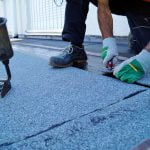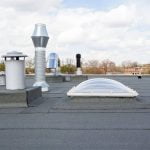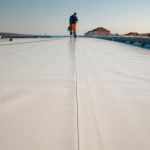How Long Does a Flat Roof Last?
A rubber roof is incredibly long-lasting and durable. The rubber used for making the synthetic rubber membrane isn’t damaged by the sun’s UV rays.
If installed correctly, you can expect a rubber flat roof to last up to 50 years.
Because an EPDM flat roof comprises durable rubber, it can withstand extreme weather conditions such as hail or snow and typical weather such as rain and strong winds.
Furthermore, if the rubber membrane is ever damaged, torn, or split, it’s straightforward to repair quickly. A flat rubber roof has been installed commonly since the 1970s, which is why it’s popular with homeowners.
It requires minimal maintenance throughout its lifetime
This makes rubber roof membranes attractive for commercial and privately owned properties. They’re incredibly cost-effective and generally have a longer lifespan than traditional materials such as asphalt or felt.
How Can I Improve My Flat Roofing Installation?
By simply installing a rubber roof membrane and always using flashing tape, even the most challenging flat roofs can be made watertight!
We also offer a range of products designed to divert rainwater from your flat roof to your drains properly.
Top 6 Rubber roofing kits
- Installation kit for internal drain
- Installation kit for horizontal drain
- Internal outlet
- Horizontal flat roof outlet
- Top Drain
- Balcony Outlet
Rainwater doesn’t affect the properties of the rubber membrane, but we offer a range of accessories designed to manage roof water runoff correctly. All our rubber flat roofs come with a 20- or 25-year warranty to certified installers.
- Unlike traditional materials such as tiles, slates, steel or felt, the roof membrane isn’t vulnerable to rust or moss growing on it, nor will it tear, split or crack.

WHY DO EPDM ROOFS LAST LONGER THAN OTHER MATERIALS?
Part of the EPDM chemical structure is made up of carbon black, which is resistant to material decomposition and degradation from UV exposure. It is also highly flexible, expanding and contracting when temperatures become cold or hot. It can withstand high winds, and its synthetic rubber composition is totally waterproof.
Its longevity was also proven when 2010, the EPDM Roofing Association (ERA) based i,n Washington DC test,ed ,roof membrane samples of at lethat weret 30 years old. ERA evaluated its mechanical and physical properties using standards set by ASTM (American Society for Testing and Materials standards). Properties evaluated included its tearistance, tensile strength and wat,er absorption amongst, others. The results proved positive, proving that even after thirty years of exposure, all ASTM minimums were exceeded or met.
Other Benefits of EPDM Rubber Roofing
The advantage of a longer lifespan is only one of the many benefits of this type of roofing material. You can find some of the other ones below.
GO GREEN
Endorsed by Greenpeace as a low impact membrane and 100% recyclable you can do your bit for the environment if you choose EPDM as your roof replacement material. The extended lifespan and reusability of EPDM mean that it has a limited impact on the environment.
COST-EFFECTIVE
Over its lifetime, EPDM is the most cost-efficient material for a flat roof. You’ll find cheaper materials, but they sacrifice longevity. Some materials, such as fibreglass, are comparable, but you can expect to pay a much higher price.
LOW MAINTENANCE
If the rubber roofing has been installed correctly, there is little post-installation maintenance to carry out.
How EPDM Has Evolved Over The Years
EPDM roofing was first introduced to the market in 1962 and became a popular alternative to asphalt during the seventies and eighties. When the Middle East oil embargo resulted in increased prices and lower-quality asphalt, EPDM positioned itself as a contender in the flat roofing market and hasn’t looked back since.
Over the decades, advancements have been made to the product making it more durable and longer-lasting than ever. Still, even the less developed EPDM roofing systems of the sixties are protecting flat roof buildings to this day, which stands as a testament to its robustness. Advancements over the years include improvements to the seams, making EPDM more puncture resistant and stronger flashing details.
How Does Rubber Compare with Other Roofing Materials?
Of course, rubber roofing isn’t the only material used for flat roofs. Let’s examine some other flat roofing materials and find out how long they last.
FIBREGLASS FLAT ROOFS, HOW LONG DO THEY LAST?
Fibreglass roofing, also known as GRP (Glass Reinforced Polyester) Roofing, can last for 30 years or more, so in longevity, it is close to EPDM. However, you also have to consider the price, which is much higher, and installation fees. Many homeowners like to install rubber roofing themselves as it is a relatively simple process and reduces overall costs. GRP involves a much more complicated installation method and needs to be carried out by a professional.
WHAT IS THE LIFESPAN OF A FELT ROOF?
A felt roof will last somewhere between 10 and 20 years. The older pour and roll method of installation has now been superseded by torch-on felt which is melt welded on to a flat roof. Felt is generally the least expensive option and was a common choice for many flat roofs before materials such as rubber became more popular. Still, even though it is cheap, it does degrade faster, can’t be DIY installed and, as pointed out, may need replacing in as little as ten years. Felt roofs.
WHAT’S THE LIFE EXPECTANCY OF TPO FLAT ROOFING?
TPO (Thermoplastic polyolefin elastomers) is the new kid on the block so it is a bit of an unknown, estimates are that it could last around 20 years. The price of a TPO flat roof is similar to that of EPDM as is its durability, but the latter is still the winner when it comes to life expectancy by a few decades.
How to Maintain a Flat Rubber Roof
Maintenance doesn’t have to be a chore, but it’s best to carry it out a couple of times a year, we’d suggest once in spring after the cold, damp winter months and once in autumn after the hot summer months. You should also check the roof after heavy rain to make sure that water isn’t pooling on it.
When you carry out your bi-annual maintenance, remove any debris, such as leaves from the roof, that could block the water from draining and cause it to pool.
If there are overhanging tree branches above your roof then cut them back, heavy branches falling on the rubber membrane could damage it.
Just as with any other roof, you will need to undertake repairs occasionally. Fortunately, there are inexpensive repair kits and patches designed for easy maintenance of an EPDM roof.
Common Issues That Can Affect the Longevity of a Flat Roof
Problems that will affect the life expectancy of your flat roof can vary depending on the material used, and as we discussed above, ensure that you do a little maintenance from time to time.
A poorly installed flat roof can also affect its performance. Either use a professional to do the work, or if you do it yourself, take your time and follow the instructions closely. Also, aim to choose the highest-quality material you can afford from a reputable dealer. Using High-quality rubber-like Flexiproof and correct installation will ensure that your investment is long-lasting.
When Does a Flat Roof Need Replacing?
If your roof is leaking, the most obvious place to start is trying to repair it, but in most cases, it will need replacing. If the leaking is extensive, you might want to use the services of a roofing professional to check that it is structurally sound enough to install new roofing.
If water is continually pooling on your roof, this could also be a sign that it needs replacing. If this frequently occurs and the water has been left over an extended time, it could cause leaking or rotting.
It might just be time to update your roofing system because it has become outdated. If you have a felt roof, for instance, and it is ten years or older, it might be best to pre-empt any roofing issues before they occur. If you invest in a new rubber roof, it is likely to be a one-off cost and could last 50 years or more giving you peace of mind that your home is protected from the elements for decades to come.
If you have further questions about maintaining and extending the life expectancy of your EPDM rubber roof, call us on 01306 776626 or contact us here. We’ll be more than happy to help you today.











